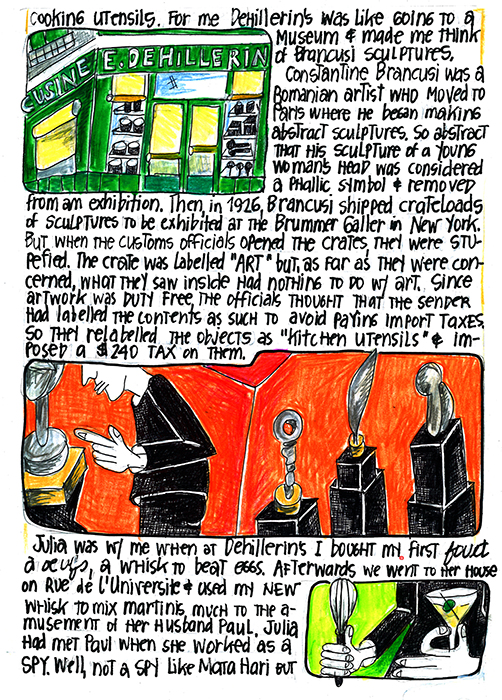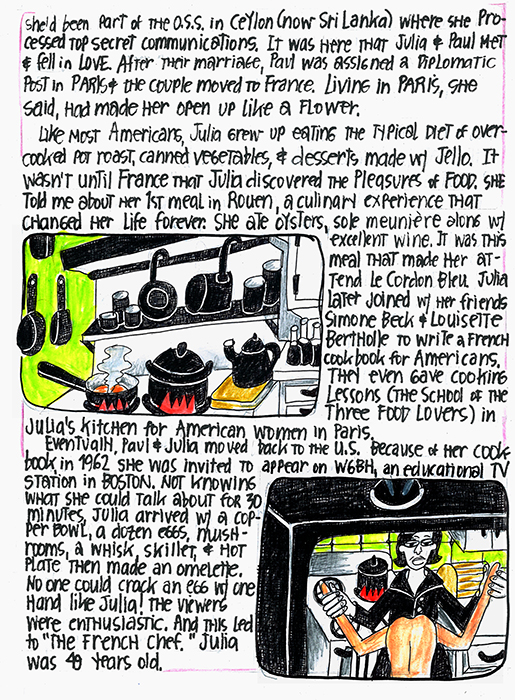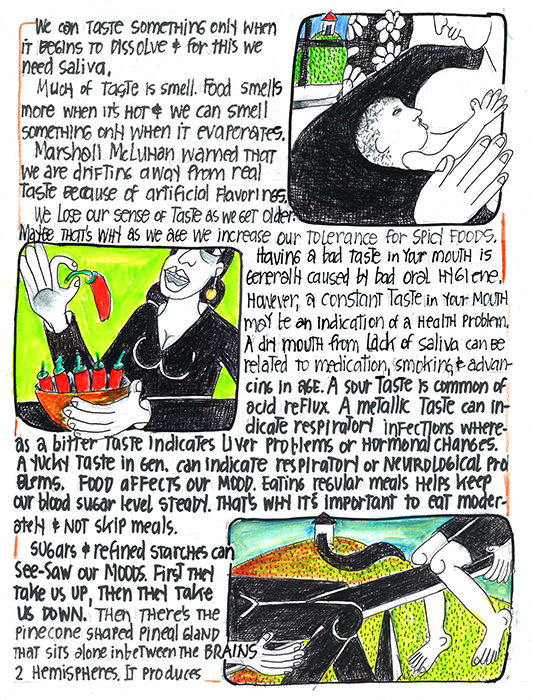Scrambling eggs was my specialty. I could scramble them with onions or cheese or mushrooms. I could also mix ‘n match them with tomatoes & basil or ground pepper & goat cheese or sour cream & bacon. Anything you could put in a sandwich, I could scramble with eggs. Unfortunately this was the extent of my culinary talents so I decided to enroll in Paris’ best cooking school, Le Cordon Bleu.
Located on rue du Faubourg Saint Honoré, the school was run by Mme Brassant, a petite but intimidating woman who was the quintessence of a Parisienne. Everyone in my class was French except an American woman who easily caught one’s eye. Her name was Julia Child and she was so tall that, when standing next to Mme Brassant, I always thought of David and Goliath.
Since we were both Americans, it was only natural that we started hanging out together. Often we’d have onion soup at the nearby Au Pied de Cochon or go to Les Halles to buy vegetables or to Dehillerin’s to buy cooking utensils. For me Dehillerin’s was like going to a museum and made me think of Brancusi sculptures.
Constantin Brancusi was a Romanian artist who moved to Paris where he began making abstract sculptures. So abstract that his sculpture of a young woman’s head was considered a phallic symbol and removed from an exhibition. Then, in 1926, Brancusi shipped crateloads of sculptures to be exhibited at the Brummer Gallery in New York. But when the customs officials opened the crates, they were stupefied. The crate was labelled “Art” but, as far as they were concerned, what they saw inside had nothing to do with art. Since artwork was duty free, the officials thought that the sender had labelled the contents as such to avoid paying import taxes. So they relabelled the objects as “kitchen utensils” and imposed a $240 tax on them.
Julia was with me when, at Dehillerin’s, I bought my first fouet à œufs, a whisk to beat eggs. Afterwards we went to her house on Rue de l’Universite and used my new whisk to mix martinis much to the amusement of her husband Paul. Julia had met Paul when she’d worked as a spy. Well, not a spy like Mata Hari but she’d been part of the O.S.S. in Ceylon (now Sri Lanka) where she processed top secret communications. It was here that Julia and Paul met and fell in love. After their marriage, Paul was assigned a diplomatic post in Paris and the couple moved to France. Living in Paris, she said, had made her open up like a flower.
Like most Americans, Julia grew up eating the typical diet of overcooked pot roast, canned vegetables, and desserts made with Jello. It wasn’t until France that Julia discovered the pleasures of food. She told me about her first meal in Rouen, a culinary experience that changed her life forever. She ate oysters, sole meunière along with excellent wine. It was this meal that made her attend Le Cordon Bleu. Julia later joined with her friends Simone Beck and Louisette Bertholle to write a French cookbook for Americans. They even gave cooking lessons (The School of the Three Food Lovers) in Julia’s kitchen for American women in Paris.
Eventually, Paul and Julia moved back to the U.S. Because of her cookbook, in 1962 she was invited to appear on WGBH, an educational TV station in Boston. Not knowing what she could talk about for 30 minutes, Julia arrived with a copper bowl, a dozen eggs, mushrooms, a whisk, skillet, and hot plate then made an omelette. No one could crack an egg with one hand like Julia! The viewers were enthusiastic. And this led to “The French Chef”. Julia was 49 years old.
Julia said cooking required courage. Once she messed up while flipping a potato cake and it fell into pieces on the stove top. She told her audience: “I messed up because I lacked the courage to do it the right way”. Then she picked up the pancake pieces, pressed them together and said “But you can always pick it up and, if you’re alone in the kitchen, who’s going to see?”
Julia died two days before her 92nd birthday. Her last meal was onion soup.
Taste
Good food is about good taste. Taste and the tongue live in symbiosis. The little bumps on the tongue are known as papillae and most of them contain taste buds. There are about 10,000 of these buds on the tongue but they wear out every 10 days or so and are replaced. But as we get older, some of those cells go away forever.
There are five types of taste buds and they are located on different parts of the tongue—sweet on the tip, salty on the sides, sour right behind, bitter on the back and umani in the middle. “Umani” is a term borrowed from the Japanese and means a “pleasant savory taste” similar to that of soy sauce.
Taste works in collaboration with the nose. When you eat, the chewed food releases chemicals that go to the nose. Olfactory receptors send messages to the brain making us conscious of the perception of taste.
Our first taste, that of our mother’s milk, leaves an eternal imprinting.
We can taste something only when it begins to dissolve and for this we need saliva.
Much of taste is smell. Food smells more when it’s hot and we can smell something only when it evaporates.
Marshal McLuhan warned that we are drifting away from real taste because of artificial flavorings.
We lose our sense of taste as we get older. Maybe that’s why as we age we increase our tolerance for spicy foods.
Having a bad taste in your mouth is generally caused by bad oral hygiene. However, a constant taste in your mouth may be an indication of a health problem. A dry mouth from a lack of saliva can be related to medication, smoking, and advancing in age. A sour taste is common of acid reflux. A metallic taste can indicate respiratory infections whereas a bitter taste indicates liver problems or hormonal changes. A yucky taste in general can indicate respiratory or neurological problems.
Food affects our mood. Eating regular meals helps keep our blood sugar level steady. That’s why it’s important to eat moderately and not to skip meals.
Sugars and refined starches can see-saw our moods. First they take us up, then they take us down. Then there’s the pinecone-shaped pineal gland that sits alone in between the brain’s two hemispheres. It produces melatonin, a hormone that regulates sexual development, sleep cycles and the aging process.
Since ancient times, mystics have given much importance to the pineal gland believing it to be the connection between the physical and the spiritual world. Considered a source of enlightenment, it’s often symbolized by an eye on the center of the forehead generally known as the Third Eye.
The Third Eye is the eye of the imagination, intuition, and visualization. But sometimes it’s closed and needs to be opened. Sunlight is very important for the pineal gland and we should soak up at least 30 minutes of sunlight every day. That’s why sundried fruits and vegetable are good for us. Dark green vegetables such as kale and other greens like turnips, mustard and collard are also important especially if eaten raw. The pineal gland also needs serotonin as found in almonds, bananas, hot peppers, rice, and potatoes.
The pineal gland does not like processed food. Nor does it like fluoride that’s often put in water and toothpaste because it calcifies the pineal gland and keeps it from functioning properly.
Process foods are full of chemicals (food additives) meant to cause cravings (so you’ll buy more). Fast foods are loaded with sugar and eating fast food all the time leads to addiction. And it’s this addiction to sugar that causes some children to suffer from attention deficits.
Taste is not just in the mouth. Whereas the French love cheese, the Chinese hate it. And Italians like butter but not the way the Danes do. Thus taste is also a cultural experience. In the words of David Le Breton, “faced with the multitude of sensations possible at any time, any society established its own selection criteria.” In other words, your cake in my mouth will not taste the same as my cake in your mouth.
The mouth is a gate that lets the outside come in.
-30-
(from Cool Breeze, aka The Age of Reconfiguration ©)

Bibliography:
Howes, David and Classen, Constance. Ways of Sensing, Understanding the Senses in Society. Routledge. NYC. 2014.
Sensual relations : engaging the senses in culture and social theory on archive.org HERE
Paterson, Mark. The Senses of Touch, Haptics, Affects and Technologies. Berg Publishers, Oxford. 2007.
The senses of touch: haptics, affects and technologies by Paterson, Mark n archive.org HERE













Pingback: Daily Aesthetics | Narratives